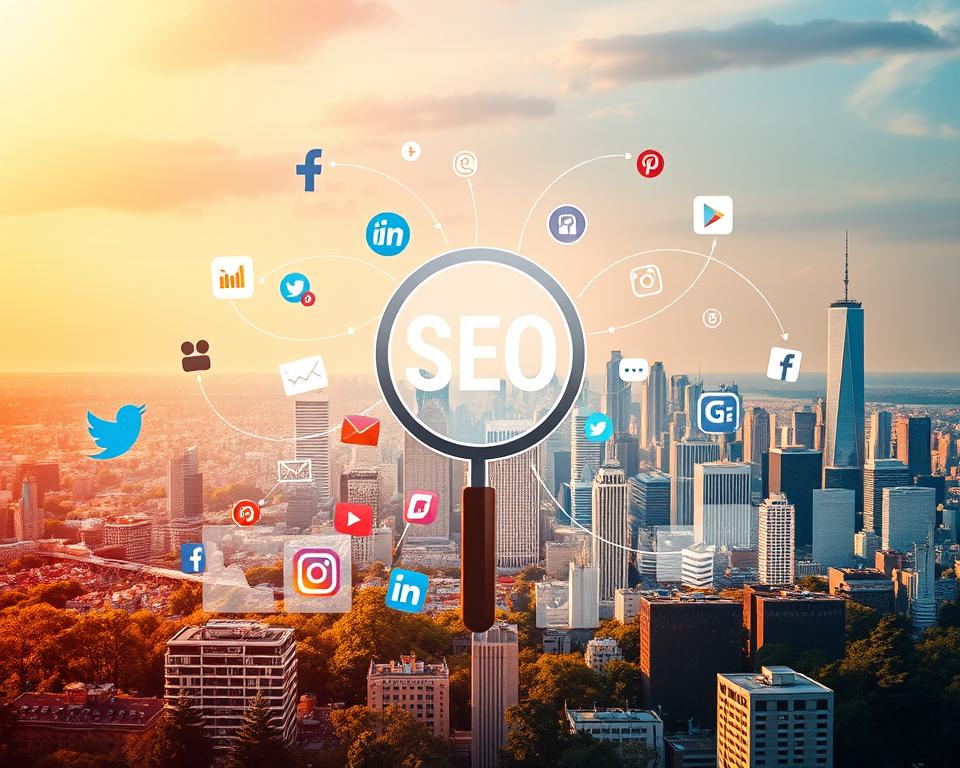The Transformation of Evolution in Digital Marketing: An Journey
Did you know that over 170M people consistently utilize social platforms, significantly altering the advertising environment? As buyers increasingly transition to digital platforms, digital marketing has emerged as a crucial tactic. It allows businesses to engage audiences on platforms where they allocate a significant amount of their time. This shift signifies the development of digital marketing transitioning from conventional methods to a more dynamic and involved strategy.
With an estimated online advertising market worth of approximately two hundred billion dollars, it’s evident that Oakland Digital Marketing Company must evolve to the current internet marketing trends. This is crucial to maintain competitiveness in this quickly evolving market.
The rise of digital channels has enabled companies to access customers that conventional advertising techniques have difficulty targeting. It’s no longer required when a simple advertisement in a publication would meet the need. Currently, targeted marketing strategies have taken center stage, using techniques like SEO strategies, social channels, and influencer partnerships.
As we explore the development of digital marketing, we will delve into major milestones and tendencies. These have molded the existing marketing framework. We will illustrate the exceptional opportunities and difficulties encountered by businesses in this digital age.
Essential Insights
- More than 170 million individuals actively engage on social networks, generating extensive promotional opportunities.
- Digital marketing is to be cost-effective than classic approaches, enabling extended reach with lower budgets.
- The worldwide online advertising market is projected to attain five hundred seventeen billion dollars by the close of 2023.
- Targeted strategies like SEO boost web visibility and engagement for companies.
- Influencers have created a $1 billion sector, transforming brand marketing.
- Organizations leveraging mobile advertising strategies can access the growing consumer trust on mobile devices.
- Allocating resources in online marketing tools, like Google Ads, enables for exact targeting based on consumer demographics.
Digital Marketing Basics
Digital marketing encompasses a variety of marketing activities across diverse online platforms. This includes social channels, electronic mail, search engines, and websites. It’s a vital aspect of current marketing, considering the growing internet engagement between audiences and brands. Businesses that understand the essentials of online marketing can craft strategies that successfully interact with their desired audiences.
The evolution of internet marketing is driven by shifting buyer behaviors. The emergence of mobile devices has revolutionized marketing and sales. Currently, businesses employ omni-channel strategies to satisfy the requirements of users who use various devices and platforms. Given the attention spans of Generation Y and Gen Z, content pieces must be captivating and impactful from the start. Studies suggest that integrating video can enhance messaging effectiveness by up to triple.
The rising role of digital marketing emphasizes the requirement to keep up of latest trends and technologies. Resources like AI-driven chatbots allow deep customer interaction, while influencers aid build trust with customers. Traditional marketing methods are no longer sufficient, emphasizing the importance of holistic digital strategies that meet current customer demands.
| Factor | Details |
|---|---|
| Buyer Behavior | Shift towards online engagement, shorter attention spans (twelve seconds for young adults, 8 seconds for Generation Z) |
| Tech Usage | Growth of mobile technology, growth of interactive tech |
| Promotional Strategies | Focus on omni-channel and influencer marketing |
| Engagement Instruments | Use of AI-driven chatbots and video content in marketing campaigns |
| Industry Evolution | Expansion of digital advertising post-2000, rise of pay-per-click ads with platforms like Google Ads |
Understanding Digital Marketing
Digital marketing includes a variety of approaches to reach customers through digital platforms. It includes Search Engine Optimization (SEO), content creation, and social media interaction. The primary goal is to successfully target and connect with target audiences using extensive data and sophisticated technologies.
The rise of internet advertising has been notable in recent years. As businesses dig deeper into the online world, the necessity for efficient online marketing tools expands. For illustration, 53% of all internet traffic comes from unpaid search results, showcasing SEO’s role in boosting visibility and visitor traffic.
Innovations in content marketing are key to a brand’s interaction with potential clients. The content marketing industry is projected to reach two trillion dollars by 2032. It’s crucial for companies to adjust their strategies to efficiently capitalize on these efforts. Captivating content builds relationships, enhancing brand allegiance and recognition.
Moreover, the importance of comprehensive customer relationship management tools has grown. Businesses that utilize consumer insights can create precision marketing campaigns. This results in improved engagement and conversion rates.
In summary, online marketing is a dynamic driver for organizations seeking to increase their digital footprint. By embracing the most recent in online advertising and cutting-edge content marketing, companies can enhance brand visibility and drive higher customer engagement.
The Evolution of Digital Marketing
The advertising landscape has experienced a major transformation over the decades. The progression of digital marketing demonstrates how the internet has transformed business communication with clients. As conventional methods shifted outdated, digital channels surfaced, providing new ways to interact with consumers and track outcomes.
Moving from Traditional to Digital: A Key Transformation
The move from traditional to digital marketing has significantly altered the marketing sector. Classic techniques like print media, radio advertising, and television presented restricted interaction. Internet advertising, however though, permits live interaction and analytics. The first clickable banner ad in 1994 marked the start of online marketing as we recognize it today.
This change enabled brands to test and refine their methods, leveraging the web to connect with customers.
The Birth of the Internet and Digital Marketing
The birth of the internet ushered in a new advertising era. In the beginning, companies launched online sites, setting the stage for internet marketing. The late 1990s saw the growth of search tools like Yahoo Search and AltaVista, showcasing the crucial role of SEO in digital marketing.
This transition established new pathways for accessing audiences actively looking for offerings, fundamentally changing consumer-brand interactions.
| Year | Milestone | Impact on Digital Marketing |
|---|---|---|
| 1994 | First interactive banner ad on HotWired.com | Beginning of online advertising |
| 1998 | Popularity of search engines rises | Introduction of SEO as a marketing tool |
| 2002 | Google releases AdWords | Changed online advertising with PPC |
| 2004 | Facebook was launched | Offered wide-ranging engagement opportunities |
| 2007 | Introduction of the iPhone | Led to the rise of mobile marketing |
| 2012 | Content marketing becomes recognized | High-quality and pertinent content becomes essential |
The 1990s: The Dawn of Digital Marketing
The Nineties were a revolutionary period for advertising, preparing the foundation for current digital landscape. The initial website was launched in 1991 by Tim Berners-Lee, indicating a crucial transformation in brand-consumer relationships. Search tools became vital for navigating the growing online world.
Significant Milestones in the 1990s
Several key moments shaped the 1990s, laying the groundwork for the future of digital marketing:
- 1991: The creation of the first website triggered a surge in interest in digital content.
- 1994: The launch of the initial clickable banner ad opened the door to internet advertising.
- Early search platforms like Archie surfaced, providing users a method to locate internet information.
- Platforms like Yahoo grew, heavily impacting the internet user experience.
Search Engines’ Influence
The 1990s saw a major effect from search engines. As companies recognized the benefit of web visibility, SEO became vital. Companies modified to search engine developments to boost their visibility to audiences. This marked a shift from rudimentary brand awareness to a emphasis on visibility and interaction, emphasizing search engines’ pivotal role in marketing.
The 2000s: SEO and Social Media Revolution
The 2000s experienced a major shift in digital marketing, driven by the rise of SEO and social platforms. Organizations emphasized enhancing their digital presence, causing a increase in SEO methods. These modifications altered how businesses communicate with consumers and how marketing approaches evolved.
Increase of SEO (SEO)
Organizations realized the significance of search tools as principal data sources. SEO turned into essential, with online platforms concentrating on material and keyword enhancement. The early 21st century launched PPC advertising, increasing digital advertising alternatives. This established the basis for advanced analytics and large-scale data in marketing.
The Emergence of Social Channels
Channels like Facebook, Twitter, and LinkedIn turned into mainstream, revolutionizing social media. They enabled companies to connect with audiences and deliver focused advertisements. The late 2000s decade also witnessed the growth of mobile marketing, with the increase of smartphones shaping strategies.
With exceeding one hundred seventy million each day users, social media’s impact on brand visibility was huge. Marketers began partnering with influencers, increasing brand awareness and sales. Social media evolved into a key part of modern digital marketing.
The Impact of Advancements in Online Advertising
The digital advertising landscape has gone through a substantial transformation with the arrival of online advertising advancements. Programmatic advertising has changed how brands interact with their audience. In the U.S., more than 90% of digital display ads rely on programmatic methods for success. This development enables targeted ad delivery, making sure the correct message gets to the intended consumer.
Digital marketing trends show a growth in native advertising efficacy. This approach, combining ads into user experiences, often exceeds traditional methods in engagement. Additionally, employing mobile app advertising has evolved into crucial, accessing the viral capability of these platforms to increase visibility.
AR in content marketing is growing. It merges digital content with real-world environments, developing engaging experiences. PWAs also focus on user experience, emphasizing speed and clarity, satisfying current consumer demands.
With approximately 315 million Americans active on social media in 2023, mobile optimization is more critical than ever. A considerable portion of advertising budgets is allocated to mobile ads, recognizing the prolonged time users spend on their devices. This shift not only boosts user experience but also increases conversion rates, driving revenue growth.
The adoption of AI tools has significantly advanced online advertising. Tools like Albert enable predictive analysis for pay-per-click campaigns, helping marketers enhance strategies with real-time data. AI-driven automation enhances marketing efficiency, allowing brands to stay competitive in a quickly transforming market.
- Automated advertising increases targeting efficiency.
- Native advertising often exceeds traditional methods.
- AR creates engaging marketing experiences.
- Mobile marketing emphasizes optimizing user experience.
- AI tools provide predictive insights for campaigns.
Adapting to digital marketing trends secures brands stay competitive in the continually shifting digital landscape.
The Decade of 2010s : The Age of Personalization
The decade of 2010s witnessed a substantial shift in digital marketing, with a focus on personalization. Advances in data analytics allowed companies to tailor their marketing to fit individual preferences and behaviors. This period highlighted the value of creating content that resonates with users, enhancing engagement and loyalty.
Targeted Marketing Strategies
Marketers in this decade turned towards customer data to create targeted campaigns. By understanding consumer behavior, brands could send personalized messages on various platforms. Personalization efforts included:
- Flexible website content that adapts based on user interactions.
- Tailored email campaigns tailored to individual preferences.
- Behavioral retargeting ads that follow users across the web.
This emphasis on targeted marketing assisted brands connect with their audience more deeply. It led to higher customer satisfaction and conversion rates.
The Function of Data Analytics in Marketing
Data analytics turned into crucial in the 2010s, aiding businesses turn vast data into useful insights. Companies used analytics to track campaign success, user engagement, and predict future behavior. Key aspects included:
- Utilizing predictive analytics to foresee customer needs and trends.
- Employing A/B testing to improve advertising approaches based on real-time data.
- Integrating social media analytics to gauge audience sentiment and preferences.
The growth of data analytics changed how marketers strategized, enabling them to create more relevant and engaging experiences. This evolution established the foundation for future trends, solidifying a customer-centric approach in digital marketing.
The Influence of Mobile Technology
The increase of mobile technology has greatly altered the digital marketing landscape. In recent years, the shift towards mobile devices, especially smartphones, has transformed consumer engagement with brands and information access. By 2021, about 85% of Americans held smartphones, a substantial jump from 35% in 2011. This rise in mobile device usage has caused changes in digital marketing strategies across various sectors.
As mobile technology evolves, brands have boosted their investment in mobile ads. An incredible $7 out of every $10 spent on advertising now goes to mobile ads. In 2020, mobile ads made up around 70% of all internet ad revenues. This indicates a clear consumer preference for mobile-friendly experiences. Businesses have accordingly focused on responsive web design and mobile optimization for seamless interactions.
- 15% of Americans use only their smartphones for internet access.
- Mobile optimization has turned into essential for reliable user experiences across devices.
- Social media platforms like Facebook and Instagram have employed mobile technology to enhance brand visibility.
- Data-driven marketing strategies enable improved understanding of customer preferences.
The development of digital marketing has also seen a transition towards personalized and targeted marketing. This has led to better engagement and conversion rates. Analytics tools have become crucial for marketers seeking to tailor their campaigns effectively. Innovations like virtual reality (VR) and augmented reality (AR) have opened new avenues for customer engagement, highlighting the dynamic relationship between mobile technology and digital marketing strategies.
Looking ahead, future trends will continue to combine technology and marketing innovation. Google’s decision to abolish third-party cookies in 2023 will require businesses to adapt their smartphone marketing tactics. Ethical concerns around data protection will influence consumer trust and influence marketing practices. As consumer behaviors change with mobile technology, brands must stay flexible to seize emerging opportunities within the changing digital marketing landscape.
Current Digital Marketing Trends
The development of digital marketing is continuing, with several trends shaping how businesses interact with consumers. Artificial intelligence and machine learning are transforming marketing strategies. These technologies enable more personalized experiences, causing higher engagement and conversion rates through data-driven approaches.
Social media platforms have experienced significant growth since their introduction in the mid-2000s. They have become essential for brand engagement, allowing businesses to connect with audiences on a personal level. Moreover, social media SEO is an emerging field, offering opportunities for content creators to improve their search engine rankings.
Video marketing is a leading technique, reflecting a preference for visual content. With growth projections, marketers must focus on creating video content to meet consumer demands.
Voice search optimization is another key trend, driven by the increasing use of voice-activated devices. Brands must adjust their content strategies to address voice queries, ensuring relevance as technology advances.
As data privacy regulations become stricter, the digital marketing landscape will change. Marketers must comply with these regulations while maintaining personalized experiences. Finding a balance between handling customer data and tailored marketing is crucial for engagement in this changing digital world.
Google’s dominance in online information retrieval, with around 90% market share, highlights the need for perfecting SEO strategies in 2024. The shift towards AI snippets and visual content is altering SEO focus, necessitating brands to enhance their strategies in response.
| Emerging Technology | Effect on Marketing | Engagement Potential for Consumers |
|---|---|---|
| Generative AI | Improves content production and personalization | High |
| Virtual Reality (VR) | Creates immersive experiences for users | Very High |
| Augmented Reality (AR) | Boosts product interaction through digital overlays | High |
| Internet of Things (IoT) | Associates devices to gather user data for targeted marketing | Moderate |
As brands delve into this new landscape, their ability to adapt will define the future of digital marketing. Adopting these technologies is not just about keeping pace; it’s about transforming customer-brand interactions. This will create a more personalized and engaging marketing environment.
Closing Remarks
The development of digital marketing has been a journey of constant innovation and adaptability. From the early internet days in the 1990s to today’s advanced strategies, businesses have always adapted. The increase of SEO, social media, and artificial intelligence shows the need for marketers to keep up with new strategies to stay ahead.
In the 2010s, methods like Media Mix Modeling and Multi-Touch Attribution created new standards for measuring marketing success. The COVID-19 pandemic also highlighted how crucial digital channels are for businesses to reach their audiences. Adapting to these changes is essential for brands seeking to succeed in our digital-first world.
Therefore, businesses must stay alert and proactive in their digital marketing efforts. By adopting new technologies and trends, they can better connect with their audience. Adopting continuous change in digital marketing strategies will enhance brand visibility and build stronger connections with consumers in today’s interconnected market.



